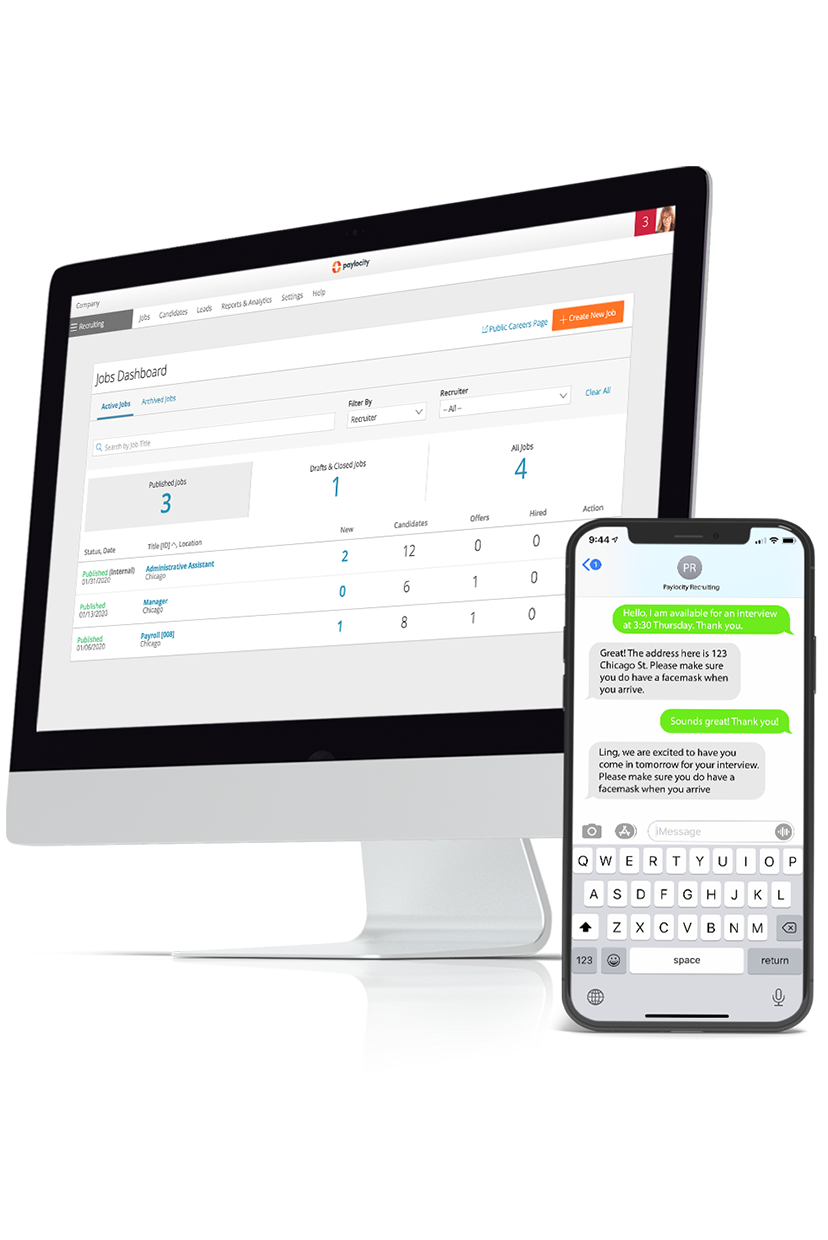resources
8 Recruiting Email Templates You Need to Attract Top Talent
January 13, 2023
Stand out in a crowded inbox with these essential email templates for recruiters.
Blog Post

From sourcing top talent to making a job offer, email templates are a powerful tool in the recruiter’s toolbox. Not only do templates save HR teams time, they ensure your communications are consistent and complete for every candidate.
But that’s not all email can do! As a key part of your recruitment marketing strategy, email keeps your employer brand front and center throughout the recruitment process. Every email you send to a potential candidate makes an impression.
Standing out in a crowded inbox will be increasingly important to attract top talent. Job seekers are getting more selective about the jobs they choose, with 78% of applicants saying they want validation that a position is worth pursuing. That means recruiters must convince top candidates that the job and the company will meet their high expectations.
One advantage of an automated applicant tracking system is giving all recruiters access to the same hiring workflows. But you can still get a little creative with your recruitment email templates.
How to Write a Good Recruiting Email
Start with your employer brand voice. Note that employer brand is different from corporate brand, although their tone is usually similar. In a good recruiting email, your voice — what you say and how you say it — gives candidates a glimpse into what it would be like to work for your organization.
A few ways you can elevate your recruitment emails:
- Be genuine and authentic. Almost a quarter of candidates (24%) say they are skeptical of promises companies make about job opportunities, perks, and culture. Honesty builds trust.
- Use formatting to call out key information. Just remember, styles like bullets and bold text may look different depending on the type of email the candidate uses (e.g., Gmail, Outlook, Mac Mail, etc.)
- Get more personal with video. To really differentiate yourself and your company, don’t make candidates read about the job — show and tell!
Check out Paylocity’s video features:
Customizing Your Recruitment Email Templates
You’re probably familiar with the main components in an email — subject line, greeting, body text, and signature. While they all serve an informational purpose, each is an opportunity to make an impression on a great candidate.
Subject line: Get their attention, but don’t be too enthusiastic!!! Avoid ALL CAPS and keep exclamation points to a minimum so your email doesn’t wind up in the junk folder. It’s better to be clear than clever, but you can still make your subject line interesting. Here are a few ideas get you started:
- We’re looking for an amazing [Job Role].
- [First Name], this position could be the right career move for you.
- [Company] is interested in your resume/application.
Greeting: It’s easy to overlook, but how you greet a candidate sets the tone for the rest of the email. Be respectful and true to your employer brand voice. But more important, make it personal. No one likes an email that starts, “Dear Applicant.”
Body text: What you include in your message depends on where the candidate is in the hiring process. Just like telling a story, though, a good recruiting email has three parts:
- Beginning — who are you and what can you offer?
- Middle — what does the candidate need to know to make a decision?
- End — what do you want the candidate to do next?
Signature: Certainly, your email signature should include your contact info. It can also boost your brand by adding your mission statement, a link to your careers site, or a differentiator like a “best of” award. Just don’t try to cram your entire “About Us” page at the bottom of your email!
Email Templates for Recruiters
These templates are a jumping off point — customize them to fit your company and culture. While you want to include enough information to intrigue candidates, focus on the details they need to take action. Don’t forget that a growing number of states and cities have pay transparency laws that require you to include compensation information in job postings.
1. Cold Outreach Recruitment Email
One big challenge with a cold recruiting email is getting the candidate to open it. Craft your subject line to appeal to your ideal candidates. A subject line for a sales job might sound different from a subject line for an engineer.
Subject Line: [Job Role] Opportunity: You caught our attention
Hi [First Name],
I’m a recruiter for [Company] and we’re looking for an outstanding [Job Role] to join our team. Your skills and experience look like a great match for this opportunity, and I wanted to quickly share a few details that might pique your interest.
In this role, you’ll get to:
[List 3-4 responsibilities from your well-written job description. For example:]
- Balance between engineering excellence, customer value, and sustained delivery by collaborating with leadership, peers, and sister teams.
- Solve highly technical, complex problems for products from inception of ideas to launch.
- Demonstrate continuous learning to raise the bar for yourself, your team, and the systems you will own.
The salary range for the position is [$XXX-$XXX] and comes with a comprehensive benefits package. Find the complete job description and apply here: [Link to Job Post].
If you have any questions, please contact me. Otherwise, I hope to see your application!
Best,
[Signature]
2. Passive Candidate Recruiting Email
A passive candidate is usually employed and not actively looking for a new job. Although a type of cold outreach, your emails to passive candidates need to quickly convince them that (a) something is missing from their career and (b) your company offers that and more.
Subject Line: [First Name], this job opportunity might interest you
Hi [First Name],
[Company] is searching for our next [Job Role] and your [profile/resume] caught my attention. I thought this might be a great opportunity to stretch your skills in [skill area] — and your career — in a new direction.
Would you be open to a 15-minute chat on [Day/Date] to talk about your goals and where [Company] might fit in your journey?
Please let me know if there’s a good time to schedule a call. I look forward to hearing from you!
Sincerely,
[Signature]
3. Follow-up Email to First Outreach
It’s great when your cold recruitment email elicits a response. More often than not, however, you will likely have to send a follow-up email to sourced or passive candidates.
Subject Line: Checking in about the opportunity at [Company]
Hi [First Name],
I wanted to make sure you saw my previous email about a [Job Role] position at [Company].
Your skills in [skill area] look like a great fit for this position. But just as important, I’d like to tell you more about what we offer to see if we’re the right place for you.
Interested? Let’s schedule 15 minutes to learn more about each other. Are you available on [Day/Date]?
I hope we can talk soon. In the meantime, you can find out about our values and read employee stories on our website: [Link]. I think you’ll like what you see!
Best,
[Signature]
4. Invitation to Interview
You may call the candidate to schedule an interview, but it’s always good to follow-up with an email so they can refer back to the details. Provide insights that will help them prepare.
Subject Line: Your Interview with [Company]: Confirmation & Details
Hi [First Name],
We’re excited to talk with you about the [Job Role] position! Below are the details you’ll need:
When: [Date/Time]
Interviewer(s): [Names, titles, and LinkedIn profiles]
Where: [Video platform information/link or address/location]
Here are some tips to help you have a great interview:
- Check out our website and reviews to learn more about our company, values, and culture. [provide links]
- Familiarize yourself with the STAR method — Situation, Task, Action, Result — to describe your work experiences.
- Dress for success! We might not know you’re wearing pajamas, but you will. Be comfortable and confident.
Please don’t hesitate to reach out to me if you have any questions or technical difficulties before meeting with the team. You’ll hear from me shortly following the interview regarding next steps.
Best of luck!
[Signature]
5. Keeping a Candidate Warm
The recruiting and hiring process seldom goes as quickly as a candidate would like. Don’t leave them hanging. Even if it turns out they aren’t the right fit for this particular job, you may want to keep them interested in your company for future opportunities.
Subject Line: Status update — [Job Role] at [Company]
Hi [First Name],
I want to keep you in the loop about your application for the [Job Role] position. We appreciate the time and energy you’ve devoted to the interview process. [Hiring Manager] is currently reviewing the best candidates for the role, and we hope to have a decision about next steps by [Timeframe].
I’ll be in touch as soon as I have more news, and certainly reach out if you have any questions.
Thank you,
[Signature]
6. Reaching Out to a Past Candidate
The goal of a recruitment strategy is to not only fill a current opening but also build your talent pipeline — which is the place to start your next search. In an email to a past candidate, the key is to let them know why this new opportunity is a better fit.
Subject Line: New Opportunity — [Job Role] at [Company]
Hi [First Name],
You made a big impression when you applied for the [Previous Job Role] position in [Month/Year], and you immediately came to mind for this new opportunity.
Although previously we [went in a different direction/chose a candidate from within/paused our search], I think your skills — especially in [skill area] — are a good match for this new [New Job Role] position.
Would you be available for a quick call to reconnect on your plans and goals?
I hope you’re doing well, and I hope to hear from you soon!
Best,
[Signature]
7. Job Offer Email
It’s common to first extend a job offer verbally to negotiate details like start date or salary. But as soon as everyone agrees, send the offer by email. You might copy the offer letter into the body of the email or send as an attachment. Include what they can expect next, but don’t forget your goal: to seal the deal.
Subject Line: Congratulations — here is your offer letter from [Company]
Dear [First Name],
We are elated to formally offer you the position of [Job Role] at [Company]. Please review, sign, and return the attached offer letter by [Date].
Once you’ve accepted, here’s what you can expect in the coming days:
[for example]
Background Check: We conduct a background check on all new employees. After we receive your signed offer letter, you will receive additional instructions.
Onboarding: Following your successful background check, our IT department will send you instructions to log into our employee onboarding portal, where you will be guided through all the required pre-hire documents.
Orientation: After onboarding, you will receive an invitation with everything you need to know about your first day — an agenda, where to go or links to access the orientation meeting online, and any other information that might be useful.
I’m certain you’ll find your decision to join [Company] a good one — now and in the future. If you have any questions, please don’t hesitate to contact me at [phone number] or [email].
Welcome to [Company]!
[Signature]
8. Rejection Email
Unfortunately, in almost any hiring situation, there are rejections. Even if you send them in bulk, be tactful and gracious. After all, this is a pool of talent that has expressed interest in your company. For candidates who progressed through the interview process, try to offer feedback.
Subject Line: [Company] Application Update
Dear [First Name],
Thank you for interviewing with us and taking the time to get to know [Company]. After careful consideration, we have selected another candidate for the position.
Our team was impressed with your skills and enjoyed speaking with you. In this case, we felt one candidate had additional experience in [skill area] that aligned especially well with this role.
We’d like to keep you informed about new opportunities as part of our talent community and encourage you to apply again in the future. In the meantime, please don’t hesitate to contact me if you have any questions.
Thanks again for your interest in [Company], and we wish you much success in your job search.
Best regards,
[Signature]
Managing the Recruitment Process
If email was the magic bullet that solved the talent acquisition challenge, recruiters wouldn’t have experienced a 28% increase in workload since the start of the pandemic. Obviously, the recruitment process is a bit more complicated.
Communicating effectively with potential candidates is one piece of the recruitment puzzle. Your company’s success is built on the ability to find candidates who can jump right in because they're just the right fit.
See how Paylocity’s Recruiting solution helps HR teams create a modern experience for candidates while streamlining the process from job posting to new hire.

Keep Your Workforce Ready
Finding the right talent for your team can be challenging in today’s market. But with the right tools, it doesn’t have to be a strain on your internal resources as well. Our recruiting platform streamlines the process, bringing you an intuitive way to search for and engage with top candidates. With communication methods like texting and video, and data that helps you track progress, attracting and winning has never been easier.


